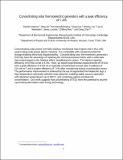Concentrating solar thermoelectric generators with a peak efficiency of 7.4%
Author(s)
Jie, Qing; Cao, Feng; Liu, Weishu; Ren, Zhifeng; Kraemer, Daniel; McEnaney, Kenneth; Weinstein, Lee Adragon; Loomis III, Robert James; Chen, Gang; ... Show more Show less
DownloadConcentrating solar and SI.pdf (2.355Mb)
PUBLISHER_POLICY
Publisher Policy
Article is made available in accordance with the publisher's policy and may be subject to US copyright law. Please refer to the publisher's site for terms of use.
Terms of use
Metadata
Show full item recordAbstract
Concentrating solar power normally employs mechanical heat engines and is thus only used in large-scale power plants; however, it is compatible with inexpensive thermal storage, enabling electricity dispatchability. Concentrating solar thermoelectric generators (STEGs) have the advantage of replacing the mechanical power block with a solid-state heat engine based on the Seebeck effect, simplifying the system. The highest reported efficiency of STEGs so far is 5.2%. Here, we report experimental measurements of STEGs with a peak efficiency of 9.6% at an optically concentrated normal solar irradiance of 211 kW m⁻², and a system efficiency of 7.4% after considering optical concentration losses. The performance improvement is achieved by the use of segmented thermoelectric legs, a high-temperature spectrally selective solar absorber enabling stable vacuum operation with absorber temperatures up to 600 °C, and combining optical and thermal concentration. Our work suggests that concentrating STEGs have the potential to become a promising alternative solar energy technology.
Date issued
2016-09Department
Massachusetts Institute of Technology. Department of Mechanical EngineeringJournal
Nature Energy
Citation
Kraemer, Daniel; Jie, Qing; McEnaney, Kenneth; Cao, Feng; Liu, Weishu; Weinstein, Lee A.; Loomis, James; Ren, Zhifeng and Chen, Gang. “Concentrating Solar Thermoelectric Generators with a Peak Efficiency of 7.4%.” Nature Energy 1, no. 11 (September 2016): 16153 © 2016 Macmillan Publishers Limited, part of Springer Nature
Version: Author's final manuscript
ISSN
2058-7546